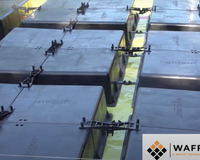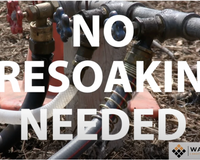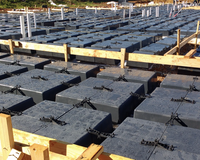Depending on its composition and texture, groundwater can have a significant impact on soil stability.
Water can completely transform soil characteristics, and if you didn’t build with this in mind, your foundation could be in serious trouble. Here’s everything you need to know about how water affects soil and what it means for construction.

How does water affect different types of soils?
Two factors are crucial in determining how water will affect different types of soil: retention and drainage. These factors will determine water movement in soil and how you should prepare your site before construction.
Soil that has high water retention suffers from high levels of expansion. Retentive soils include compositions with substantial levels of silt or clay.
Water can easily penetrate sandy soil, making it ideal for drainage, while paved materials like concrete and cement offer poor drainage. If water cannot penetrate soil, it creates runoff that can cause more problems and other areas of your construction project.
Poor drainage can also occur in soil with a high potential for retention when it becomes oversaturated. This is where local climate and weather events become critical to understanding the potential of your site’s soil.

Which type of soil has the greatest water retention?
The primary factor determining a soil’s water retention capacity is particle size. The smaller the particle size, the greater the retentive properties of the soil. Here is a list of soil types ordered from the least to the most potential for water retention:
- Coarse sand
- Fine sand
- Loamy sand
- Sandy loam
- Fine sandy loam
- Silt loam
- Silty clay loam
- Silty clay
- Clay
Clay soil has the highest capacity for water retention, which makes it great for agricultural purposes but not for construction. This is why a foundation built on soil with a high clay content should always have protection against the way it behaves when exposed to water.
Clay expands when saturated and contracts as it dries, wreaking havoc on the structure it supports. It creates pressure on foundations known as slab heave, an upward pressure beneath your home’s foundation. Slab heave leads to cracks in your walls and foundation, causing significant structural damage that requires expensive repairs.
If your soil report indicates a high clay content, expect these pressures to become more of an issue as it is exposed to moisture through weather and groundwater movement.

Tracking water movement in soil
Groundwater is fresh water that is stored in the pores between soil particles. It makes up 95% of freshwater resources in the US, feeding rivers, lakes, and streams. This makes it a significant water source that needs to be assessed before any project can begin.
Soil saturation occurs when these pores are completely filled with groundwater, creating runoff streams on the surface and replenishing the aquifer. The critical thing to consider for construction is the water table height and potential for soil saturation near the surface.
The water table exists between the saturated and unsaturated zones of soil. You can also think of the water table as the depth where a hole will continue to fill with water. This makes it incredibly difficult to build on and presents many issues for the long-term integrity of a foundation. Ideally, your water table will be far below your foundation depth.
You can still build on a site with a high water table, but you shouldn’t attempt to do so with a traditional foundation or without additional protective measures. The best solution for building on soil with a higher water table or areas where soil saturation is a frequent problem is to use an above-ground foundation system like Wafflemat.
Factors affecting soil water retention
Various factors can affect how your soil reacts to water. Although, no matter what kind of soil you have, any soil composition can become overly saturated given enough water. This is why geotechnical engineers always consider environmental factors such as local climate and major weather events when analyzing your site’s soil reactivity.
Factors affecting soil water:
- Water table
- Soil composition
- Soil texture
- Proximity to water sources
- Local climate
- Organic matter
These factors will determine how your soil behaves when exposed to water. This information should be summarized in your geotechnical soil report, along with expert recommendations on how to proceed with construction.
Learn how to protect your foundation from groundwater
Groundwater can cause unexpected delays and expenses in a construction project. Learn how you can protect your foundation from groundwater and a high water table by reading our articles from experts in the field.
Or, Contact a Wafflemat Staff Member Today to chat with one of our experts.





